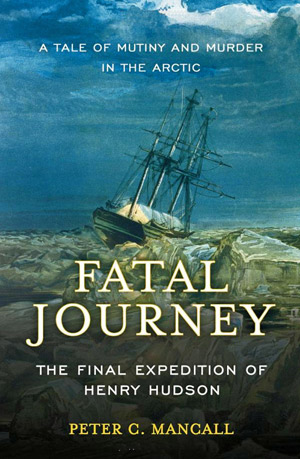Fatal Journey:
The Final Expedition Of Henry Hudson

Support Canada's History in other ways (more)
by Peter C. Mancall
Basic Books, New York, 2009, $33.95
In the spring of 1611, after being stranded on the southern shore of James Bay during an unimaginably brutal winter, Henry Hudson’s crew was sick, starving, demoralized, and desperate to return to England. But Hudson had other plans. It was the English explorer’s fourth attempt to discover a northern route from Europe to the Orient and its highly coveted spice markets — a route that “remained the greatest prize any explorer could find.” This time he was determined to take that prize.
When the ice finally released the Discovery from its crushing grip, Hudson prepared to press on. Fearful that they may end up spending another winter in the Arctic, a few of the men decided to take matters into their own hands. Hudson, his seventeen- year-old son John, and seven others were forcefully removed from the vessel and set adrift in a small
shallop without food or weapons. What befell Hudson and the others after the mutineers sailed off in the Discovery is a mystery that has intrigued scholars for centuries. In Fatal Journey: The Final Expedition of Henry Hudson, Peter C. Mancall, a professor of history and anthropology at the University of Southern California and an expert on the history of travel and discovery, draws on a variety of sources to recreate the events surrounding the mutiny and the disappearance of Hudson.
This fascinating tale of greed, ambition, adventure, betrayal, and murder is a significant part of our history, yet today it has been all but forgotten. Hudson’s saga, Mancall says, reveals a great deal about “one of the darker chapters of the European age of discovery.” It was a time when spices “had become not just a commodity but an obsession for people across England.” This craving for spices spawned cartels such as the East India Company, which backed expeditions to sail in search of a northern route that would allow quick access to the spice markets of the East Indies.
By 1610, Henry Hudson was a highly skilled navigator whose previous voyages in search of a Northeast Passage had taught him a great deal about sailing in Arctic waters. But Hudson’s final voyage seemed doomed from the start. By the time the Discovery ran aground on the rocky shore of James Bay that fall, tensions among the crew were running high.
Mancall portrays Hudson as an ambitious but humane captain who frequently demonstrated concern for the well-being of his crew. However, he made some questionable decisions that raised doubts about his command, caused dissent among the crew, and ultimately sealed his fate.
After the mutineers sailed away in the Discovery, they encountered a group of Inuit and a scuffle broke out. Four of the sailors were mortally wounded and died shortly after returning to the ship. Conveniently, the survivors claimed it was the ringleaders of the insurrection who had died. Those who made it back to England were tried for the murder of Henry Hudson, but never convicted.
Mancall’s beautifully written narrative evokes all the wonder and terror of venturing into what was, for Europeans, terra incognita. The explorers’ harrowing encounters with icebergs, polar bears, and Inuit, as well as the misery and “horrors that extreme cold produced,” are all vividly depicted. Mancall also paints a lucid picture of the characters and conflicts that gave rise to the mutiny.
What was Hudson’s final fate? This, Mancall says, is a question that’s easy to ask but difficult to answer. Fatal Journey nonetheless comes as close as is today possible to unravelling the mystery.
— Joyce Glasner (Read bio)
Joyce Glasner is a Halifax-based freelance writer and author.